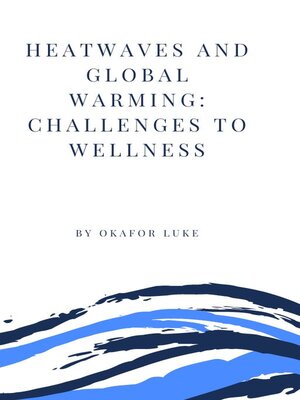Heatwaves and Global Warming
ebook ∣ Challenges to Wellness · Creating Appropriate Awareness on Diseases and Fitness-Related Topics
By LUKE OKAFOR

Sign up to save your library
With an OverDrive account, you can save your favorite libraries for at-a-glance information about availability. Find out more about OverDrive accounts.
Find this title in Libby, the library reading app by OverDrive.



Search for a digital library with this title
Title found at these libraries:
| Library Name | Distance |
|---|---|
| Loading... |
The extended periods of abnormally high temperatures relative to the expected conditions for a specific region and season called heatwaves, are among the most deadly and potentially devastating impacts of global warming. As greenhouse gas emissions continue to rise, the frequency, intensity and duration of heatwaves are projected to increase, posing significant risks to wellness, ecosystems and infrastructure. Heatwaves are often associated with specific weather patterns, including high-pressure systems that trap warm air masses, leading to prolonged periods of hot and stagnant conditions. Understanding the underlying causes of heatwaves, implementing effective mitigation strategies and developing adaptive measures are imperative in the face of this escalating threat existence.
Global warming, primarily driven by the increased concentration of greenhouse gases in the atmosphere, is a key contributor to the intensification of heatwaves. Elevated levels of carbon dioxide and other greenhouse gases trap heat, leading to rising global temperatures.
Urban areas are particularly susceptible to heatwaves due to the urban heat island effect. Buildings, concrete, and asphalt absorb and re-radiate heat, resulting in higher temperatures compared to surrounding rural areas.
Extreme heat can have severe health consequences, ranging from heat exhaustion and heatstroke to exacerbating pre-existing conditions. Vulnerable populations, including the elderly, young children, and those with underlying health issues, are particularly at risk. Prioritizing the needs of all vulnerable populations, is crucial in heatwave resilience efforts.
Addressing the root cause of global warming requires aggressive efforts to reduce greenhouse gas emissions. This includes transitioning to renewable energy sources, increasing energy efficiency and adopting sustainable transportation options. Shifting away from fossil fuels towards renewable energy sources such as solar, wind, and hydroelectric power is essential in reducing carbon emissions and curbing global warming.
Implementing energy-efficient practices in buildings, transportation and industrial processes can significantly decrease energy consumption and associated emissions. Encouraging public transportation, cycling and walking, as well as adopting electric vehicles, can help reduce the carbon footprint of transportation systems. Increasing forested areas and reforesting degraded lands can serve as carbon sinks, absorbing and sequestering atmospheric carbon dioxide.
Designing cities with green spaces, shade and cool roofs can mitigate the urban heat island effect, making urban areas more resilient to heatwaves. Constructing buildings with energy-efficient designs, natural cooling systems, and climate-resilient materials can reduce energy demand and enhance indoor comfort during heatwaves.
Implementing effective early warning systems that provide timely information about impending heatwaves is needful for allowing communities to take proactive measures. Embracing technological advancements, such as advanced weather forecasting and smart city initiatives, can enhance early warning systems and response capabilities. Establishing designated cooling centers in public spaces and implementing emergency response plans can provide safe haven for individuals during extreme heat events.
Educating communities about the risks of heatwaves and providing guidance on how to stay safe and cool is essential in building resilience. Integrating green infrastructure for heat resilience, such as urban parks and green roofs, into city planning can help reduce urban temperatures and provide cooling relief.
As...







